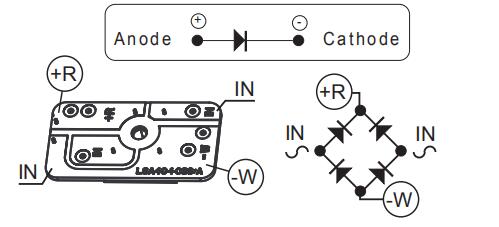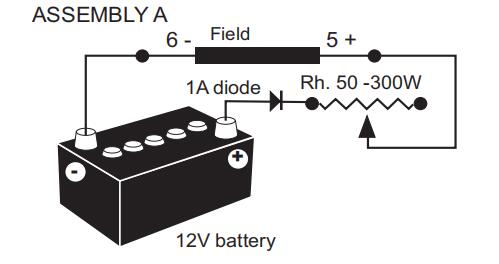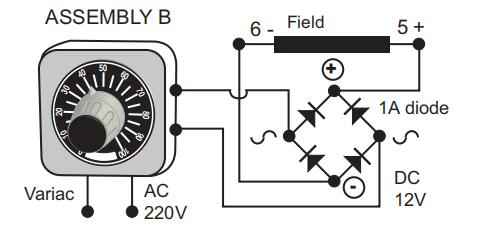4.1 - Safety measures
Servicing or troubleshooting must be carried out strictly in accordance with instructions so as to avoid the risk of accidents and to maintain the machine in its original state.
All such operations performed on the alternator should be undertaken by personnel trained in the commissioning, servicing and maintenance of electrical and mechanical components, who must wear personal protective equipment appropriate for mechanical and electrical hazards.
Before any intervention on the machine, ensure that it cannot be started by a manual or automatic system and that you have understood the operating principles of the system.
Warning: During and after running, the alternator will reach temperatures hot enough to cause injury, such as burns.
4.2 - Routine maintenance
• Checks after start-up
After approximately 20 hours of operation, check that all fixing screws on the machine are still tight, plus the general state of the machine and the various electrical connections in the installation.
• Electrical servicing
Commercially-available volatile degreasing agents can be used.
Do not use: trichlorethylene, perchlorethylene, trichloroethane or any alkaline products.
These operations must be performed at a cleaning station, equipped with a vacuum system that collects and flushes out the products used.
The insulating components and the impregnation system are not at risk of damage from solvents. Avoid letting the cleaning product run into the slots.
Apply the product with a brush, sponging frequently to avoid accumulation in the housing. Dry the winding with a dry cloth. Let any traces evaporate before reassembling the machine.
• Mechanical servicing
Cleaning the machine using water or a high pressure washer is strictly prohibited. Any problems arising from such treatment are not covered by our warranty.
Degreasing: Use a brush and detergent (suitable for paintwork).
Dusting: Use an air gun.
If the machine is fitted with air inlet and outlet filters, the maintenance personnel should clean them routinely at regular intervals. In the case of dry dust, the filter can be cleaned using compressed air and/or replaced if it is clogged.
After cleaning the alternator, it is essential to check the winding insulation (see sections 3.2 and 4.5).
4.3 – Bearings
The bearings are permanently greased | Approximate life of the grease (depending on use) = 20,000 hours or 3 years. |
4.4 - Mechanical defects
Fault | Action | |
Bearing | Excessive overheating of one or both bearings (bearing temperature 80°C above the ambient temperature) | - If the bearing has turned blue or if the grease has turned black, change the bearing. - Bearing not fully locked (abnormal play in the bearing cage) - End shields incorrectly aligned |
Abnormal temperature | Excessive overheating of alternator frame (more than 40° C above the ambient temperature) | - Air flow (inlet-outlet) partially clogged or hot air is being recycled from the alternator or engine - Alternator operating at too high a voltage (>105% of Un on load) - Alternator overloaded |
Vibrations | Too much vibration | Misalignment (coupling) - Defective mounting or play in coupling - Rotor balancing fault (Engine -Alternator) |
Excessive vibration and humming noise coming from the machine | - Phase imbalance - Stator short-circuit
| |
Abnormal noise | Alternator damaged by a significant impact, followed by humming and vibration | - System short-circuit - Misparalleling Possible consequences - Broken or damaged coupling - Broken or bent shaft end - Shifting and short-circuit of main field - Fan fractured or coming loose on shaft - Irreparable damage to rotating diodes/AVR, surge suppressor |
4.5 - Electrical faults
Fault | Action | Effect | Check/Cause |
No voltage at no load on start-up | Connect a new battery of 4 to 12 volts to terminals E- and E+, respecting the polarity, for 2 to 3 seconds | The alternator builds up and its voltage is still correct when the battery is removed. | - Lack of residual magnetism |
The alternator builds up but its voltage does not reach the rated value when the battery is removed. | - Check the connection of the voltage reference to the AVR - Faulty diode - Armature short-circuit | ||
The alternator builds up but its voltage disappears when the battery is removed. | - Faulty AVR - Field windings open circuit (check winding) - Main field winding open circuit (check the resistance) | ||
Voltage too low | Check the drive speed | Correct speed | Check the AVR connections (possible AVR failure) - Field windings short-circuited - Rotating diodes burnt out - Main field winding short-circuited - Check the resistance |
Speed too low | Increase the drive speed (do not touch the AVR voltage pot. (P2) before running at the correct speed)
| ||
Voltage too high | Adjust AVR voltage potentiometer | adjustment ineffective | Faulty AVR |
Voltage oscillations | Adjust AVR stability potentiometer | If no effect: try normal / fast recovery modes (ST2) | - Check the speed : possibility of cyclic irregularity - Loose connections - Faulty AVR - Speed too low when on load (or LAM set too high) |
Voltage correct at no load and too low when on load(*) | Run at no load and check the voltage between E+ et E- on the AVR | Voltage between E+ and E–SHUNT < 6V - AREP < 10V | - Check the speed (or LAM set too high) |
Voltage between E+ and E– SHUNT > 10V - AREP >15V | - Faulty rotating diodes - Short-circuit in the main field. Check the resistance. - Faulty exciter armature. Check the resistance. | ||
(*) Warning: During single-phase operation, check that the sensing wires from the AVR are connected to the correct output terminals. | |||
Voltage disappears during operation | Check the AVR, the surge suppressor, the rotating diodes, and replace any defective components | The voltage does not return to the rated value.
| - Exciter winding open circuit - Faulty exciter armature - Faulty AVR - Main field open circuit or short circuited |
(**) Warning: The AVR internal protection may cut in (overload lost connection, short circuit). | |||
• Checking the winding
You can check the winding insulation by performing a high voltage test. In this case, you must disconnect all AVR wires.
WARNING! Damage caused to the AVR in such conditions is not covered by our warranty.
• Checking the diode bridge
A diode in good working order should allow the current to flow only in the anode-to-cathode direction.

• Checking the windings and rotating diodes using separate excitation
During this procedure, make sure that the alternator is disconnected from any external load and inspect the terminal box to check that the connections are fully tightened.
1) Stop the unit, disconnect and isolate the AVR wires.
2) There are two ways of creating an assembly with separate excitation.
Assembly A: Connect a 12 V battery in series with a rheostat of approximately 50 ohms - 300 W and a diode on both exciter field wires (5+) and (6-).

Assembly B: Connect a “Variac” variable power supply and a diode bridge on both exciter field wires (5+) and (6-).
Both these systems should have characteristics which are compatible with the field excitation power of the machine (see the nameplate).
3) Run the unit at its rated speed.
4) Gradually increase the exciter field current by adjusting the rheostat or the variac and measure the output voltages on L1 - L2 - L3, checking the excitation voltage and current at no load (see the machine nameplate or ask for the factory test report). When the output voltage is at its rated value and balanced within 1% for the rated excitation level, the machine is in good working order. The fault therefore comes from the AVR or its associated wiring (I.e. sensing, auxiliary windings).

More information about Leroy-Somer low voltage alternator, please read the following articles:
Copyright © Guangxi Dingbo Generator Set Manufacturing Co., Ltd. All Rights Reserved | Sitemap
Update cookies preferences